Unit5 Do you have a soccer ball说课稿
- 格式:doc
- 大小:25.50 KB
- 文档页数:1
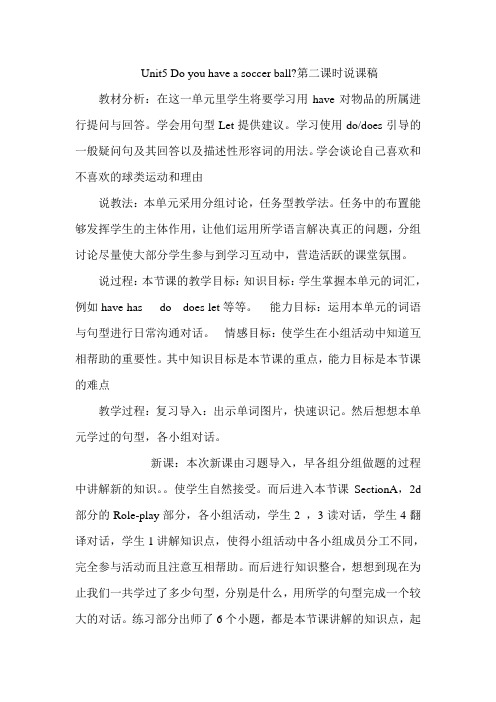
Unit5 Do you have a soccer ball?第二课时说课稿教材分析:在这一单元里学生将要学习用have对物品的所属进行提问与回答。
学会用句型Let提供建议。
学习使用do/does引导的一般疑问句及其回答以及描述性形容词的用法。
学会谈论自己喜欢和不喜欢的球类运动和理由说教法:本单元采用分组讨论,任务型教学法。
任务中的布置能够发挥学生的主体作用,让他们运用所学语言解决真正的问题,分组讨论尽量使大部分学生参与到学习互动中,营造活跃的课堂氛围。
说过程:本节课的教学目标:知识目标:学生掌握本单元的词汇,例如have has do does let等等。
能力目标:运用本单元的词语与句型进行日常沟通对话。
情感目标:使学生在小组活动中知道互相帮助的重要性。
其中知识目标是本节课的重点,能力目标是本节课的难点教学过程:复习导入:出示单词图片,快速识记。
然后想想本单元学过的句型,各小组对话。
新课:本次新课由习题导入,早各组分组做题的过程中讲解新的知识。
使学生自然接受。
而后进入本节课SectionA,2d 部分的Role-play部分,各小组活动,学生2 ,3读对话,学生4翻译对话,学生1讲解知识点,使得小组活动中各小组成员分工不同,完全参与活动而且注意互相帮助。
而后进行知识整合,想想到现在为止我们一共学过了多少句型,分别是什么,用所学的句型完成一个较大的对话。
练习部分出师了6个小题,都是本节课讲解的知识点,起到巩固的作用。
作业部分记忆本节课单词,病自己独立完成编对话任务。
这就是本节课的说课内容,在整节课当中还有许多不成熟的地方,请大家提出宝贵意见。

Unit5 Do you have a soccer ball?Section A Grammar Focus说课稿Good afternoon, everyone. It’s my great honor to stand here to show my class. My topic is “Do you have a soccer ball? Grammar Focus3c ”. I’ll talk about it by 4 parts: teaching design, teaching process, application of information technology, innovation and reflection.Part 1.Analysis of teaching designIt includes the analysis of teaching material, the analysis of teaching objectives, analysis of important and difficult points , teaching methods and learning methods.The lesson is the second period of Unit5 《Do you have a soccer ball?》. The main content of this unit is to talk about the ownership of things. The use of the verb "have" is the main point of the lesson.According to the content, I set up the objectives as follows:Knowledge & Ability Objectives1.Students master the words do,does, play,great and the words about sports2. Students can ask and answer questions with"have"Process & Method Objectives1.To develop students’ municative abilities by making conversations;2.To develop their cooperative petence by group work.Emotion & Values ObjectiveTo cultivate patriotism through the learning of sports.Students are initially exposed to the auxiliary verbs leading to general questions, it's easy to confuse the use of do in different persons.So I focus on theuse of have when the subject is the third person singular.And focus on the use of do in different persons,which is also the difficulty of this lesson.According to the teaching aims and the features of students, Intuitive Teaching Method, Situational Teaching Method, Game Teaching Method and Taskbased Teaching Method will be adopted.Students can learn this lesson by pair work and group work, their ideas are inspired through cooperation and explore grammatical knowledge by observe induction.Part 2. Analysis of Teaching ProcessIn this lesson, I used 5E grammar teaching mode. Namely experience, exchange, explore, exalt and extend. Now, I show my content in Chinese.Step1.体验我采用直观教学法播放中国女排夺冠视频,吸引学生注意力,激发学习热情。
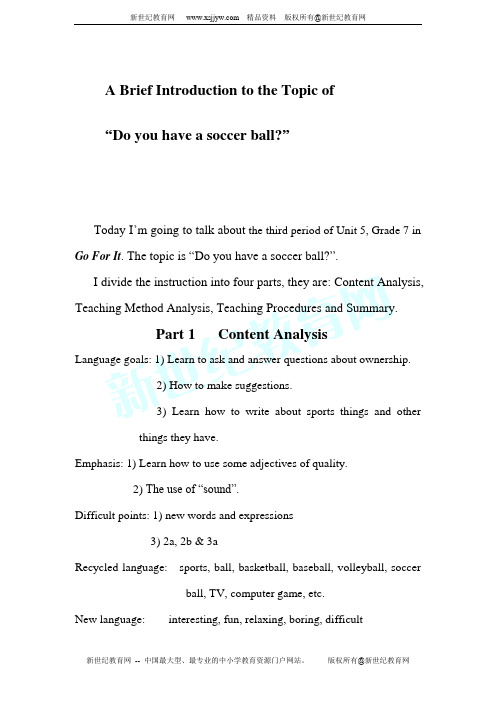
A Brief Introduction to the Topic of“Do you have a soccer ball?”Today I’m going to talk about the third period of Unit 5, Grade 7 in Go For It. The topic is “Do you have a soccer ball?”.I divide the instruction into four parts, they are: Content Analysis, Teaching Method Analysis, Teaching Procedures and Summary.Part 1 Content AnalysisLanguage goals: 1) Learn to ask and answer questions about ownership.2) How to make suggestions.3) Learn how to write about sports things and otherthings they have.Emphasis: 1) Learn how to use some adjectives of quality.2) The use of “sound”.Difficult points: 1) new words and expressions3) 2a, 2b & 3aRecycled language: sports, ball, basketball, baseball, volleyball, soccerball, TV, computer game, etc.New language: interesting, fun, relaxing, boring, difficultlet’s play tennis.That sounds interesting. / No, that sounds boring.Ed Smith has a great sports collection.But he doesn’t play sports- he only watches them onTV.Maybe all the teachers here have got the content. It’s clear that the new words and expressions are not very difficult for our students. But I think it’s still necessary for me to give them enough time to practice, because vocabulary is a very important point for our English learners. They are just like stones and bricks of a house. Without them, students will get into trouble in learning English.(That’s all for Part 1, next I’ll show you Part2)Part 2 Teaching Method AnalysisTeaching Method: 1) Tasked-Based language teaching method2) “Learning by doing, learning by using”3) Students-centered, people-orientedEmotion factors: 1) By describing the ownership of sports things,students learn to enjoy the happiness of having acollection.2) Enjoy the pleasure of communication3) Improve interest of learning English4) Enhance students’ self-confidenceIn this lesson, I will mainly use Task-Based language Teaching Method. I think if I want to improve my students’oral English, I must give them more chances to practice. That is “learning by doing, learning by using”. In this case, I designed a lot of tasks according to New English Curriculum. I will lead my students to study and cooperate with each other. Because New English Curriculum points out that the general aim of English teaching in this stage of Junior Education is to cultivate students’comprehensive ability of using English. I think my teaching methods are in line with the requirement of New English Curriculum.I will also use multi-media. I think, if I want my students to keep interested in English, I must try my best to attract their attention. Multi-media is a very good way to do that. (So much for part 2, le t’s come to the next part –Part 3)Part 3 Teaching ProceduresI design 8 steps in this lesson.Step 1 Group Presentation & Warming--up (5′) First of all, I will ask my students to have a group presentation about their preparation of the lesson. I will greet my students as usual, and encourage them to communicate with me. And let the students feel happy and relaxed in my class.Step 2 “ What’s missing?” Game (2 ′)In this step I will show some interesting pictures to my students. I will ask my students to look at these pictures very carefully and try to find which picture is missing. If they know which picture is missing, they should stand up and tell me loudly. In this way, students will be interested in playing this game, they will review the words they learned and they will feel fun in leaning English as well. The CAI photos and students’ quick reactions may bring us the first high point.Step 3 Drill & Practice (6′)In this step, I will show some pictures of my students and some key words on the screen. The people in the picture are their classmates. I will ask the students to guess what they have. They are supposed to use the sentence patterns like “Does he/she have…?”“Do they have…?”. Because the people in the pictures are very familiar to my students, they can surely arouse the students’ interest of speaking and learning English. And then I will ask them to have a group work to practice “Do you have…? Does he/ she have…?”.I will also add some emotion education here. For example: when my students guess the answers right, such as “ XX has a basketball.” I will talk to the student in the picture: Let’s play basketball! The student maybe will say “OK, that sounds interesting.”Then I will teach them that sharing things with others is a very happy thing. And I will ask themto repeat it. They will be glad to do that.Another important thing for me in this stage is to guide my students to practice in many different kinds of ways. For example, chain-drills, wave-practice, boys and girls, left and right, front and back and so on. Till they become very familiar with the target language. The CAI photos and the changeable practice may bring us the first high point.Step 4 Act & Guess( 6′)In this step, I will use some interesting and exaggerated pictures to teach some new descriptive adjectives, such as: interesting, fun, boring, relaxing, etc. In 1b on page 28, students are supposed to draw pictures and let other students guess what the pictures mean. That is Draw & Guess. I think it will be more interesting to change it into Act & Guess. I will give each group a short conversation like “ Let’s watch TV. ”“ That sounds boring”. I will ask each group to choose 2 students to act the conversation without talking. The other students in the group are supposed to guess the conversation and then all the class read the conversation. I think my students’lively actions and facial expressions will give not only them but also us the joy of speaking and learning English. This will be the second high point of this lesson.Step 5 Listen & Practice (6′)2a & 2b is a listening exercise. It’s the difficult point of this lesson ,too. It mainly trains students to get useful information from listening materials. I will guide my students to finish 3 tasks to breakthrough it Task 1: Listen and check the words that you hear in 1a.First students listen and check the words they hear. This task is quite easy.Task2: Write a word from 1a in each blank.Next students listen again and write a word from 1a in each blank. It’s a little difficult. I will ask my students to do it in pairs. And when checking, I’ll give some necessary explanations too.Task 3 Pairwork (2c)Finally students are supposed to act the conversation in pairs.By finishing the three tasks, most students can master some listening skills and understand the article quite well. And they can also learn how to get useful information from listening materials, how to report and how to cooperate with each other.Step 6Group study ( read, discuss, ask questions and raise problems) (10′)In this step, students are supposed to study in groups. First they read the passage in 3a, and then they discuss about it to ask some questions about the content of the passage. The more questions, the better. And other groups are supposed to answer the questions. Then students are supposed to raise problems . I will ask: Which words or sentences aredifficult for you to understand? Then other students are supposed to solve the problems. If there is a problem that no students can solve, I will give them some help. In this step, students learn to think themselves, ask questions and answer questions themselves , raise and solve problems themselves. By doing this, students can grasp the target language quite well in an expressive and creative way. This will be the third high point of this lesson.Step 7 Writing practice (8′)In this step, students are asked to write their own passages according to the sentence patterns they have just learned in 3a. They can write not only about sports things but also something they are interested in. And then I will ask each group to give a passage and read it together.Step 8 Chant (2′)I prepared a chant about the sentence patterns by a piece of rhymed music. Students revise the target language in a very happy way and the class is over in the fourth high point.Part 4 SummaryIn my class my students are happier and happier. They feel more and more interested in English along with my teaching procedures. Why?Because during my teaching, I always try my best to get my class alive and encourage the students to cooperate and communicate with each other. They listen, talk, read and write. So students in my class can really learn by doing, learn by using. They can not only grasp the target language well, but also increase comprehensive abilities in a very pleasant way.That’s all. Thank you.。
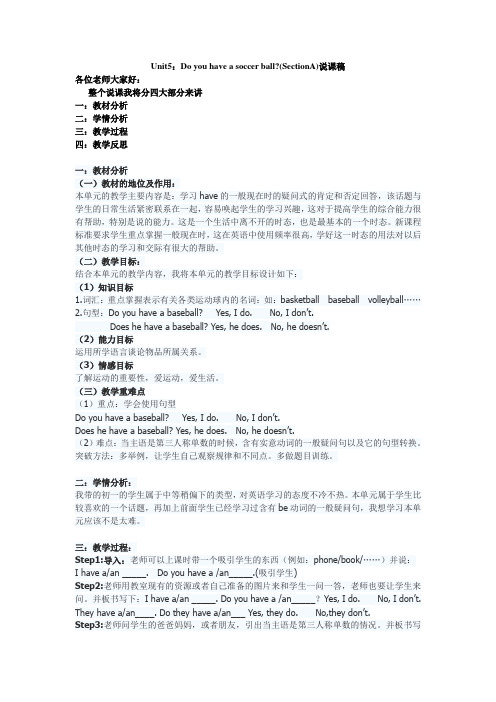
Unit5:Do you have a soccer ball?(SectionA)说课稿各位老师大家好:整个说课我将分四大部分来讲一:教材分析二:学情分析三:教学过程四:教学反思一:教材分析(一)教材的地位及作用:本单元的教学主要内容是:学习have的一般现在时的疑问式的肯定和否定回答,该话题与学生的日常生活紧密联系在一起,容易唤起学生的学习兴趣,这对于提高学生的综合能力很有帮助,特别是说的能力。
这是一个生活中离不开的时态,也是最基本的一个时态。
新课程标准要求学生重点掌握一般现在时,这在英语中使用频率很高,学好这一时态的用法对以后其他时态的学习和交际有很大的帮助。
(二)教学目标:结合本单元的教学内容,我将本单元的教学目标设计如下:(1)知识目标1.词汇:重点掌握表示有关各类运动球内的名词:如:basketball baseball volleyball……2.句型:Do you have a baseball? Yes, I do. No, I don’t.Does he have a baseball? Yes, he does. No, he doesn’t.(2)能力目标运用所学语言谈论物品所属关系。
(3)情感目标了解运动的重要性,爱运动,爱生活。
(三)教学重难点(1)重点:学会使用句型Do you have a baseball? Yes, I do. No, I don’t.Does he have a baseball? Yes, he does. No, he doesn’t.(2)难点:当主语是第三人称单数的时候,含有实意动词的一般疑问句以及它的句型转换。
突破方法:多举例,让学生自己观察规律和不同点。
多做题目训练。
二:学情分析:我带的初一的学生属于中等稍偏下的类型,对英语学习的态度不冷不热。
本单元属于学生比较喜欢的一个话题,再加上前面学生已经学习过含有be动词的一般疑问句,我想学习本单元应该不是太难。
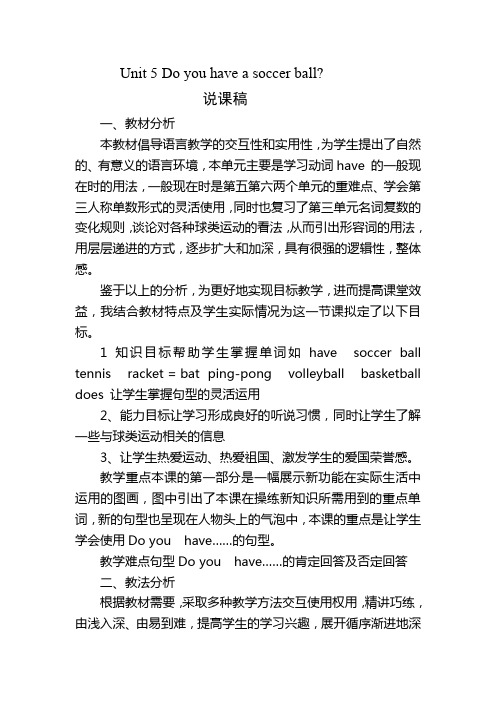
Unit 5 Do you have a soccer ball?说课稿一、教材分析本教材倡导语言教学的交互性和实用性,为学生提出了自然的、有意义的语言环境,本单元主要是学习动词have 的一般现在时的用法,一般现在时是第五第六两个单元的重难点、学会第三人称单数形式的灵活使用,同时也复习了第三单元名词复数的变化规则,谈论对各种球类运动的看法,从而引出形容词的用法,用层层递进的方式,逐步扩大和加深,具有很强的逻辑性,整体感。
鉴于以上的分析,为更好地实现目标教学,进而提高课堂效益,我结合教材特点及学生实际情况为这一节课拟定了以下目标。
1知识目标帮助学生掌握单词如have soccer ball tennis racket=bat ping-pong volleyball basketball does 让学生掌握句型的灵活运用2、能力目标让学习形成良好的听说习惯,同时让学生了解一些与球类运动相关的信息3、让学生热爱运动、热爱祖国、激发学生的爱国荣誉感。
教学重点本课的第一部分是一幅展示新功能在实际生活中运用的图画,图中引出了本课在操练新知识所需用到的重点单词,新的句型也呈现在人物头上的气泡中,本课的重点是让学生学会使用Do you have……的句型。
教学难点句型Do you have……的肯定回答及否定回答二、教法分析根据教材需要,采取多种教学方法交互使用权用,精讲巧练,由浅入深、由易到难,提高学生的学习兴趣,展开循序渐进地深化教学内容,展开以教师为主导、以学生为主体师生双边活动,主要以直观教学、交际性教学和任务型教学,贯穿整个教学过程,增加了直观性和趣味性,激发学生兴趣,活跃课堂气氛,提高教学效果。
三、学法指导我所采用的教法有助于学生掌握以下学法1、科学地储备大量的学生感兴趣的课外知识,学生掌握了感受兴趣的丰富的课外知识才能进行良好、积极的语言交流。
2、掌握大量的语法知识、学生要交流就必须了解语言规律,丰富词汇、熟悉语法规则,学会由各个话题而展开的交际内容,这样学生的知识才记得深刻,灵活度大3、及时巩固、反复记忆教师在课堂上所讲的语言难点、重点、学生应及时整理、再次认识并积极使用。
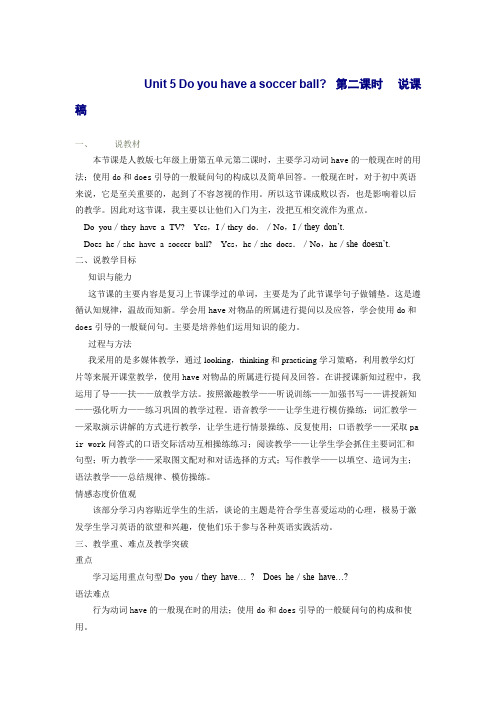
Unit 5 Do you have a soccer ball?第二课时说课稿一、说教材本节课是人教版七年级上册第五单元第二课时,主要学习动词have的一般现在时的用法;使用do和does引导的一般疑问句的构成以及简单回答。
一般现在时,对于初中英语来说,它是至关重要的,起到了不容忽视的作用。
所以这节课成败以否,也是影响着以后的教学。
因此对这节课,我主要以让他们入门为主,没把互相交流作为重点。
Do you/they have a TV?Yes,I/they do./No,I/they don’t.Does he/she have a soccer ball?Yes,he/she does./No,he/she doesn’t.二、说教学目标知识与能力这节课的主要内容是复习上节课学过的单词,主要是为了此节课学句子做铺垫。
这是遵循认知规律,温故而知新。
学会用have对物品的所属进行提问以及应答,学会使用do和d oes引导的一般疑问句。
主要是培养他们运用知识的能力。
过程与方法我采用的是多媒体教学,通过looking,thinking和practicing学习策略,利用教学幻灯片等来展开课堂教学,使用have对物品的所属进行提问及回答。
在讲授课新知过程中,我运用了导——扶——放教学方法。
按照激趣教学——听说训练——加强书写——讲授新知——强化听力——练习巩固的教学过程。
语音教学——让学生进行模仿操练;词汇教学——采取演示讲解的方式进行教学,让学生进行情景操练、反复使用;口语教学——采取pair work 问答式的口语交际活动互相操练练习;阅读教学——让学生学会抓住主要词汇和句型;听力教学——采取图文配对和对话选择的方式;写作教学——以填空、造词为主;语法教学——总结规律、模仿操练。
情感态度价值观该部分学习内容贴近学生的生活,谈论的主题是符合学生喜爱运动的心理,极易于激发学生学习英语的欲望和兴趣,使他们乐于参与各种英语实践活动。
《Doyouhaveasoccerball》说课稿《Do you have a soccer ball》说课稿《Do you have a soccer ball》说课稿1Unit 5 Do you have a soccer ballGood morning, ladies and gentlemen:Nice to meet you here. I'd like to say it's a good chance for me to learn from you .Here, my speech contains 4 parts. I would like to introduce them here with your great help.I. The *ysis of teaching material:My speech is Section A , Unit 5. Do you have a soccer ball This is an important lesson in Book One. And it is the first lesson of this unit, it talks about recognizing objects(mainly about balls) and the simple question. .The students have already known to answer it“Yes" or "No" in Unit 2 ,but in this unit, it's different. We know, simple question is a kind of important structure. If the students can learn it well, it will be helpful to make the students to learn the special question. And it's related to our daily life closely, so it's very useful.New words: basketball, soccer ball, volleyball, ping-pong ball, ping-pong bat, tennis, tennis racket.Structure: Do you have Does he /she haveTeaching aims:Aims on the knowledge:To study the words about balls by showing the pictures.To make the students know how to ask whether others have something or not, and how to answer it.Aims on the abilities:To develop the students' ability of listening ,speaking, reading and writing.To train the students' ability of munication.Aims on the emotion:⑴.To make the students be interested in good co-operation and petition.⑵To make the students love sports ,love life.Teaching key points and difficult points:How to make the students understand the new language items naturally.How to make the students work well with their partners.How to arouse their interest in learning English.How to make dialogues and act them out.Ⅱ.Teaching methods I will take.1."Communicative" teaching method.2. "Task-based" teaching method.Everyone knows that the main aims of learning English in middle school is to cultivate the students' basic abilities of listening, speaking, reading and writing, and their good sense of the English language.Ⅲ. Learning methods.Firstly, Look, listen, and say to gain language petence.Secondly, Teamwork, exploration and participation to reach the goal.Thirdly, Cultivate skills in listening, speaking, reading and expressing.Fourthly, Students-centered and teacher-guided learning strategies. I'm not a teacher but a guider. I'm ready to give them help whenever they need and re-correct the mistakes while talking.Ⅳ.Teaching procedure design.Step1. Warm-up.Ask the students some easy questions to check if they have remembered the contents they had learned before. For example: What's this Spell it, please. What color is it Is this your pen Is thatyour backpack and so on.Step2. Presentation.1. Take out a ping-pong ball and ask the students:What's this Why I take out a ping-pong ball here I think it's the easiest and the most popular in our country.2. Leading in new words : here I will play some short plays, they are soccer game,volleyball game, ping-pong petition and an advertisiment, there is a basketball in it.The reason of my design: I think the students can learn the words easily and directly in this way. And I also think it can draw the students' attention and arouse their interest in learning English. With the help of the CAI, it can provide a real situation to understand the meaning of the words, not by presenting the new words one by one and telling them the Chinese meaning. So the students can remember the words quickly and naturally.How to help the students remember the new word, I think I will do it like this: When the word appears under the picture, there may be some students know the word and they will read it out loudly, this time, you may need to correct the pronunciation and teach it, after one or two times, I will ask the students to spell it by themselves. Why I must ask them to spell it themselves, I thinkit can make them have a general impression of the word. Usually, when you teach them read, most of the students just follow you, they don't look at the word at all. Perhaps, you have taught ten times and they can read it very well following you , but after you teach some more words and ask them to read it again ,they may not be able to.3.Teaching the dialogue:Make a sample dialogue with a student. Show him or her the ping-pong ball and do it like this:T: I have a ping-pong ball. Do you have a ping-pong ball (Here, you may help him answer "Yes, I do." or "No, I don't.") S: Yes, I do.Make the dialogue with some more students,and write it on the blackboard. Make sure they can read and understand the meaning. Next, ask a student if he has a ping-pong ball, then ask the others: "Does he have a ping-pong ball "Here, you must help them answer: "Yes, he does." Or "No, he doesn't." Write it on the blackboard. Teach the dialogue and make sure they can read it and understand the meaning.4. Practice: Read the dialogue by role play. But you must tell them how to do it clearly, make them to ask their partners whatkind of balls they have. This time ,they must use the sentence "Do you have a "5. Groupworking and petition: Divide the students into groups of three.Give them an example first :A: Do you have a basketballB: Yes ,I do.A: Does he have a basketballC : Yes, he does.Ask them to make a similar dialogue and tell them that it' s also a petition, after they act it out you will choose a best group at the end.The reason of having a petition: I think it can encourage them to try their best and cooperate with their groupmembers well.6. Listening, listen to the tape and circle the words you hear. It's Activity 1a.Step3. Post-task. Starting a ball club.In this club, there are four teams: a basketball team, a soccer ball team, a ping-pong ball team and a tennis team. I will ask four students to be the captain of each team. They should ask their classmates to be their team members. If he has a basketball,he should join the basketball team.The reason I give this task: I think this activity is the consolidation of this lesson. It is helpful to revise and consolidate the contents we learned in this lesson.Blackboard design:Ping-pong ball /bat Do you have a ping-pong ballSoccer ball Yes, I do./No, I don't.BasketballVolleyball Does he have a soccer ballTennis racket Yes, he does.Does she have a volleyballNo, she doesn't.That's my speaking. Thanks for your listening.《Do you have a soccer ball》说课稿2各位老师:大家好!今天我说课的内容是七年级英语上册第五单元第一课时,这一课时可分为三部分,一是要求掌握一些球类运动的名词,英语单词是学好英语的基础,只有掌握大量的英语单词,在丰富知识的同时,才能提高应用语言的能力;第二部分是听力训练;第三部分是口语训练Do you have a 。
unit5Doyouhaveasoccerball说课稿Unit5 Do you have a soccer ball? 说课稿This lesson is Review of Unit 5 in《Go For it》Book 1. It talks about the sports.I. Teaching Aims and DemandsThe students should learn and grasp grammar: verbs in Simple Present Tense.To develop the students’ ab ilities of speaking, and writing.To train the ability of cooperation.Language goalIn this unit, students learn to talk about the sportsII. Teaching Important and Difficult Points1、Teach the students the procedures of writing2、Teach the students to use verbs in Simple Present Tense.III.Teaching Aids:Pictures, tape player, projectorV. Teaching ProceduresI design five tasks to review this unit.Step 1 Greetings Greet students as usual.Step 2 Study goals.1. Review words and phrases in this unit.2. Review target languages in this unit.3. Review the grammar (how to change the verbs to the third person singular ones )4. Learn to write a passage to talk about the sports you like.Step 3 PresentationTask 1 Review the wordsShow some pictures to review the important words in this unit. basketball, volleyball, tennis ball, ping-pong ball, ping-pongbat, soccer ball, baseball, baseball bat.Task 2 Review the phrasesAsk students to translate the important phrases in this unit.Task 3 Target LanguageShow a sample for students and ask them to make similar conversations. A: Do you have a volleyball?B: Yes, I do.A: Where is your volleyball?B: It is under my chair.A: Let’s play volleyball.B: That sounds fun.Task 4 GrammarFirst, show a video to teach them how to change the verbs to the third person singular ones and how to use verbs correctly in Simple Present T ense.Then, finish exercises to consolidate the grammar.Task 5 Writing假如你是Tony,你在Green Middle School上学,请你写一篇短文介绍你和你的朋友喜欢的运动及其原因。
Unit5 Do you have a soccer ball?说课稿一、说教材1.教学内容(1)词汇:have ,soccer,ball,tennis racket,ping-pong ball,volleyball,basketball sport ,bat,(2)语言结构:A、Do you have a ping-pong ball?Yes,I do。
Do you havea ping-pong bat?Not,I do not。
Does she/he have a pen?Yes,she/he does2.教材的地位及其作用本单元的教学主要内容是:学习have的一般现在时的疑问式的肯定和否定回答,该话题与学生的日常生活紧密联系在一起,容易唤起学生的学习兴趣,这对于提高学生的综合能力很有帮助,特别是说的能力。
本单元仍在继续学习一般现在时,这是一个生活中离不开的时态,也是最基本的一个时态。
新课程标准要求学生重点掌握一般现在时,这在英语中使用频率很高,学好这一时态的用法对以后其他时态的学习和交际有很大的帮助。
二、说目标1.语言知识词汇:重点掌握表示有关各种运动球类的名词, 如basketball, soccerball,so on重点句型:? Do you/they have a TV?Yes,I/they do./No,I/they don’t.Does he/she have a soccer ball?Yes,he/she does./No,he/she doesn’t.2.语言技能能看着图片说:Do you/they have a TV?Yes,I/they do./No,I/they don’t. Does he/she have a soccer ball?Yes,he/she does./No,he/she doesn’t.通过与同学交流,学会使用一般现在时的疑问形式及肯定和否定回答。
Good morning, everyone! my name is Li Ruimin, I’m from Xi Ma middle school. It is my great honor to be here to share my teaching design with you. I’d like to begin thispresentation with s even parts. Now let me present them one by one.Part1 The Analysis of Teaching MaterialThis lesson is from section A(1a1c) of unit 5 in Grade seven,It is mainly talking about ownership.The topic of this unit is spending time with friends. It is related to our daily life,so it is important to study them.Part 2The Analysis ofTeaching ObjectivesAccording to the new curriculumstandard, I think the teaching aims are the followings:First, the language ability is to grasp some important vocabularies such as tennis , pingpong, bat,soccer, ball and so on. And the important sentence such as “Do you have a pingpong bat? Yes, I do/No, I don’t.Second, the culture awareness is to help students express their opinions about doing activities correctly.Third, the quality of thinking is to improve students’ awareness of loving sports and loving themselves.Part 3 Teaching Key Point and Difficult PointAccording to the analyses above,Iset the key point is the usage of key words. The d ifficult pointis how to develop students’ listening andspeaking skills..Part4 The Analysis of StudentsThe students in Grade seven have got some basic English, they are eager to learn, eager to show. But some of them have no enough bravery to speak English.. So it is important for the teacher to help them open their mouth to speak English.Part 5 Teaching MethodsBased on the content, I mainly adopt different teaching methods. For example,municative teaching method,Taskbased teaching method and cooperative learning approach. At the same time, I encourage students to finish the task actively. Give the class to the students and let them feel they are the masters of the class.Part 6 Teaching ProceduresIn this part, I have seven steps to say.Step1.LeadinAt the beginning of the class, I show a video to the students. Beforewatching it, I ask a question “How many kinds of sports are there in the video?” The Purpose of my designis to lead in the topic and catch students' attention about the topic.Step 2. PresentationFirst, I show some pictures on the flash, ask students to read the new words for several times. Then do a game “quick eyes”and a match toconsolidate these words. Next, ask the students to finish the exercises in 1a. After checking the answers, let them read the dialogue on the picture. Finally ask the students to make their own dialogues and act them out. The purpose is to help students to grasp important words and the basic sentence.Step 3. ListeningLet the students listen carefully and circle the words they hear, then check the answer. Next , read the dialogue in 1c together. Pay attention to pronunciation and intonation. It aims to improve the students’listening and reading abilities .Step 4. PracticeIn order to consolidate the key words and the important sentence, the teacher design three activities.First, show some pictures and the sentence structure on the flash, according to the information, let some students ask questions,the others answer .Then, do Pair work. When the students are ready, let some of them show their dialogues in front of the class. Claps will be rewarded to good performers.Step 5. SummarySummarize the key words and the important sentence , let the students read again. Later let them know the benefit of sports. The purpose is to improve these teenagers’ awareness of loving sports.Step 6. HomeworkLet the students write some sports things they have . It helps them grasp the content better.Step 7. Black designUnit 5 Do you have a soccer ball?.—Do you have a pingpong bat?Yes, I do.Do you have a pingpong ball?No, I don’t.Part 7 Teaching ReflectionsIn my opinion, it is successful. My reasons are as follows:Firstly, the teaching objectives are quite clear. All the activities are focused on the theme.Secondly, the teacher promotes students’motivation and arouse students’ interestto learn English.That’s all! Thanks for your listening.。
Unit5 Do you have a soccer ball?第二课时说课稿
学情分析:
七年级的学生对英语学习都有兴趣的,但还没养成良好的英语语言学习习惯,而且抽象思维能力较低,形象思维能力强,注意力容易分散。
本课采用游戏、小组活动、歌曲等形式,增强学生的兴趣和注意力。
根据教育心理学,如果学生对于一件事物有极大的兴趣,他们就会排出主观和客观的种种消极因素,尽量全身心地投入到知识的学习中去。
另外,学生对英语学习兴趣还不稳定,但好奇心强,求知欲旺盛。
对刺激记忆手段多的知识记忆深刻。
教学目标
知识目标:学生掌握本单元的词汇,例如have has do does let等等。
能力目标:1学会使用助动词do和does引导的一般疑问句
.. 2学会用Let’s…提建议。
情感目标:使学生在小组活动中知道互相帮助的重要性。
教学重点难点分析
教学重点:
1.词汇:have, soccer ball ,ping-pong ball ,basketball baseball ,tennis ,ping-pong bat ,tennis racket.
2.句型:I have a/an… I don’t have a/an…
A: Do you have a /an…?
B: Yes,I do./ No,I don’t.
A: Do they/… have a /an…?
B: Yes,they do./ No,they don’t.
教学难点:
1.运用助动词do。
2.除you外,其他人称使用have的用法。
四、教学方法
1.以多媒体现代化辅助教学手段,贯穿整个教学过程,迅速抓住学生的注意力。
2.通过图片、食物的展示和纸条信息协助,进行pair work和group work操练及看图写话练习等,训练学生听说读写能力。
教学过程:复习导入:出示单词图片,快速识记。
然后想想本单元学过的句型,各小组对话。
新课:本次新课由习题导入,早各组分组做题的过程中讲解新的知识。
使学生自然接受。
而后进入本节课SectionA,2d部分的Role-play部分,各小组活动,学生2 ,3读对话,学生4翻译对话,学生1讲解知识点,使得小组活动中各小组成员分工不同,完全参与活动而且注意互相帮助。
而后进行知识整合,想想到现在为止我们一共学过了多少句型,分别是什么,用所学的句型完成一个较大的对话。
练习部分出师了6个小题,都是本节课讲解的知识点,起到巩固的作用。
作业部分记忆本节课单词,病自己独立完成编对话任务。
这就是本节课的说课内容,在整节课当中还有许多不成熟的地方,请大家提出宝贵意见。